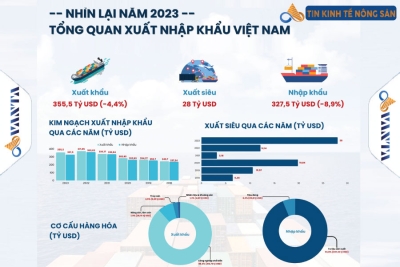"SHOCK" Export Prices Surge due to Freight Rates
Numerous foreign shipping companies have announced an increase in maritime freight rates due to the impact of conflicts in the Red Sea, continuing to pose ongoing challenges for import-export businesses.
Maritime freight rates have risen by 50-200%.
According to the Vietnam Association of Seafood Exporters and Producers (VASEP), Vietnam's seafood exports will face additional difficulties as maritime freight rates begin to surge. Major shipping lines such as Yang Ming Line, One, Evergreen Line, HMM, Maersk, and others have issued notices stating that they will impose additional fees starting from January 2024 due to the need to change the routes of Asian-European lines, avoiding the Suez Canal and the Red Sea region.
High maritime freight rates present a significant challenge for businesses. (Photo: Tan Vu Port - Hai Phong)
According to businesses, starting from January 2024, shipping costs from Vietnam to the port of Los Angeles (West Coast of the United States) will increase by $800 to $1,250, depending on the route. Specifically, in December 2023, the freight rate was $1,850, but it has now risen to $2,873-2,950. Freight rates from Vietnam to New York (East Coast of the United States) have recorded even larger increases, ranging from $1,400 to $1,750, depending on the route. Specifically, in December 2023, the price was $2,600, but it has now risen to $4,100-4,500.
Freight rates to European Union (EU) destinations have experienced significant increases as well. For instance, shipments to Hamburg, Germany, in December 2023 were priced at $1,200-1,300, but they have now soared to $4,350-4,450, more than doubling.
Around 80% of goods bound for the East Coast of the United States/Canada and the EU pass through the Suez Canal. Due to the Hamas-Israel conflict and attacks by Houthi political-military forces in Yemen, which are believed to be related to Israel when entering the Red Sea, shipping lines have had to detour around the Cape of Good Hope (South Africa), resulting in an additional 7-10 days of travel time. This has led to longer ship turnaround times and increased transportation costs (a round trip takes about two weeks). Some shipping routes have had to cancel weekly shipments, leading to space shortages or the introduction of additional vessels, thereby increasing costs.
"The increase in maritime freight rates will pose a new challenge for seafood businesses in 2024. If tensions in the Red Sea persist or escalate, it could lead to increased transportation costs and higher input prices for aquaculture and seafood processing, affecting the competitiveness and profitability of businesses," stated VASEP.
High maritime freight rates pose significant challenges for businesses.
Not only seafood but also textile and garment exports, agricultural products, and wood are industries facing the heavy impact of rising maritime freight rates.
On January 9, representatives from Dony Garment Company Limited stated that a shipment of clothing to be exported to Jordan was stuck at the port in Singapore for nearly three weeks due to a change in the shipping line's route. "The shipping line switched to a different route, causing a delay of 10-14 days. Since the beginning of the new year, export-oriented companies have faced difficulties due to the sudden surge in transportation costs that couldn't be anticipated," said Mr. Nguyen Quang Anh, Director of Dony Garment Company Limited.
Phuc Sinh Group, one of Vietnam's leading agricultural export companies with a wide range of products such as coffee, black pepper, and spices, is facing significant challenges. Prior to the recent tensions in the Red Sea and the surge in shipping costs, Phúc Sinh used to export 5-10 containers of goods daily. However, the rapid increase in shipping fees has caused a halt in their export activities and a sharp decline in shipments.
Representatives of the company have announced that shipping costs from Vietnam to the Middle East, particularly Israel, have increased by over 200%, from $1,800 to $6,000 - $7,000 per container. The fees for shipments to the United States have also risen by over 100%, from nearly $2,000 to $4,500 - $5,000 per container. The most notable increase is observed in shipments to the EU market, which have surged from $600 to $4,000 per container.
Exporters are facing immense challenges due to the surge in shipping costs
Minh Thong Phan, Chairman of the Board of Directors of Phuc Sinh Group, commented, "Shipping fees have gone crazy and have been persistently high for over a month now, mainly because shipping companies want to take advantage of the situation. Even a strong company like Phuc Sinh is struggling with these fees, so smaller companies will undoubtedly face significant difficulties." With the rising costs of coffee beans and now the substantial increase in shipping fees, it is uncertain how long the market will be able to tolerate these conditions.
The agricultural and aquaculture export sectors, which were previously advantageous, are now encountering numerous difficulties due to the escalating transportation costs.
"At present, we have had to temporarily suspend exports and renegotiate contracts with partners to share risks and costs equally, with each party bearing 50%. Despite being objective difficulties, the current situation poses significant challenges to the agricultural export activities of the company, " said Mr. Thong
According to Quoc Manh Tran, Chairman of the Board of Directors of Sadaco Production and Trading Joint Stock Company in Ho Chi Minh City, the peak season for timber consumption and wood products has already passed. New orders for the first quarter of 2024 only account for 20-30% compared to previous years' averages. The number of orders is relatively low, primarily aimed at market exploration. However, customer demands require new designs, better quality, and more competitive prices. Companies in this sector are striving to reduce costs in order to survive and adapt to avoid being left out of the competition.
Mr. Manh expressed his concerns: “The recent surge in shipping fees has dealt a heavy blow to the survival efforts of businesses. Although the fees have only increased on certain routes, we worry that this issue will create a domino effect on all other routes and the entire logistics industry. Many companies are uncertain about how long they can sustain this situation.”
Source: Young People's Newspaper
 VN
VN








